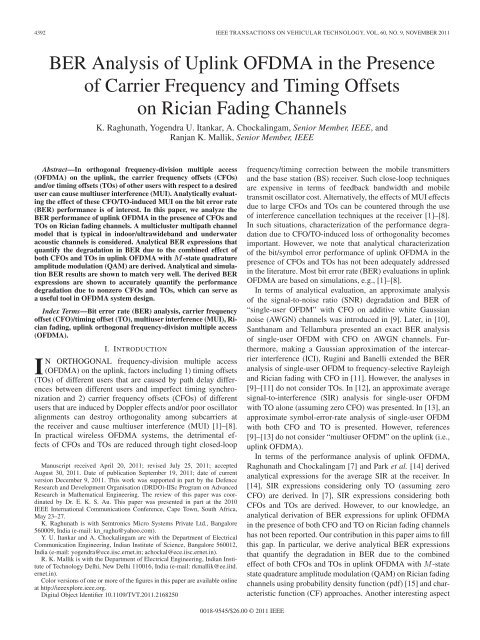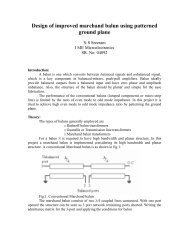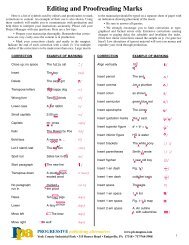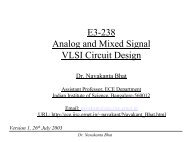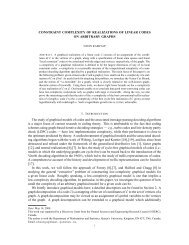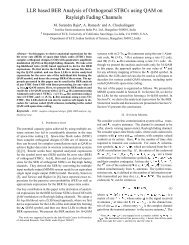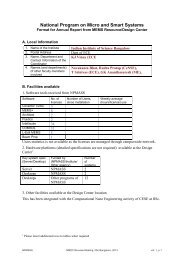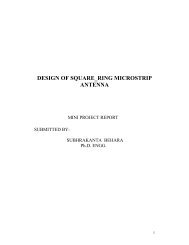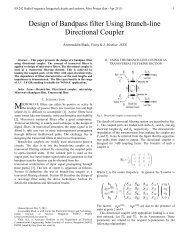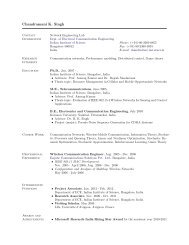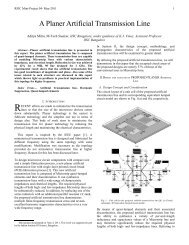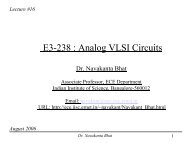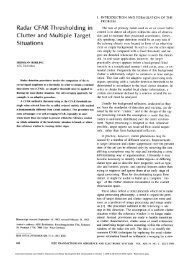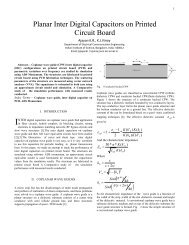BER Analysis of Uplink OFDMA in the Presence - Electrical ...
BER Analysis of Uplink OFDMA in the Presence - Electrical ...
BER Analysis of Uplink OFDMA in the Presence - Electrical ...
You also want an ePaper? Increase the reach of your titles
YUMPU automatically turns print PDFs into web optimized ePapers that Google loves.
4392 IEEE TRANSACTIONS ON VEHICULAR TECHNOLOGY, VOL. 60, NO. 9, NOVEM<strong>BER</strong> 2011<strong>BER</strong> <strong>Analysis</strong> <strong>of</strong> <strong>Upl<strong>in</strong>k</strong> <strong>OFDMA</strong> <strong>in</strong> <strong>the</strong> <strong>Presence</strong><strong>of</strong> Carrier Frequency and Tim<strong>in</strong>g Offsetson Rician Fad<strong>in</strong>g ChannelsK. Raghunath, Yogendra U. Itankar, A. Chockal<strong>in</strong>gam, Senior Member, IEEE, andRanjan K. Mallik, Senior Member, IEEEAbstract—In orthogonal frequency-division multiple access(<strong>OFDMA</strong>) on <strong>the</strong> upl<strong>in</strong>k, <strong>the</strong> carrier frequency <strong>of</strong>fsets (CFOs)and/or tim<strong>in</strong>g <strong>of</strong>fsets (TOs) <strong>of</strong> o<strong>the</strong>r users with respect to a desireduser can cause multiuser <strong>in</strong>terference (MUI). Analytically evaluat<strong>in</strong>g<strong>the</strong> effect <strong>of</strong> <strong>the</strong>se CFO/TO-<strong>in</strong>duced MUI on <strong>the</strong> bit error rate(<strong>BER</strong>) performance is <strong>of</strong> <strong>in</strong>terest. In this paper, we analyze <strong>the</strong><strong>BER</strong> performance <strong>of</strong> upl<strong>in</strong>k <strong>OFDMA</strong> <strong>in</strong> <strong>the</strong> presence <strong>of</strong> CFOs andTOs on Rician fad<strong>in</strong>g channels. A multicluster multipath channelmodel that is typical <strong>in</strong> <strong>in</strong>door/ultrawideband and underwateracoustic channels is considered. Analytical <strong>BER</strong> expressions thatquantify <strong>the</strong> degradation <strong>in</strong> <strong>BER</strong> due to <strong>the</strong> comb<strong>in</strong>ed effect <strong>of</strong>both CFOs and TOs <strong>in</strong> upl<strong>in</strong>k <strong>OFDMA</strong> with M -state quadratureamplitude modulation (QAM) are derived. Analytical and simulation<strong>BER</strong> results are shown to match very well. The derived <strong>BER</strong>expressions are shown to accurately quantify <strong>the</strong> performancedegradation due to nonzero CFOs and TOs, which can serve asa useful tool <strong>in</strong> <strong>OFDMA</strong> system design.Index Terms—Bit error rate (<strong>BER</strong>) analysis, carrier frequency<strong>of</strong>fset (CFO)/tim<strong>in</strong>g <strong>of</strong>fset (TO), multiuser <strong>in</strong>terference (MUI), Ricianfad<strong>in</strong>g, upl<strong>in</strong>k orthogonal frequency-division multiple access(<strong>OFDMA</strong>).I. INTRODUCTIONIN ORTHOGONAL frequency-division multiple access(<strong>OFDMA</strong>) on <strong>the</strong> upl<strong>in</strong>k, factors <strong>in</strong>clud<strong>in</strong>g 1) tim<strong>in</strong>g <strong>of</strong>fsets(TOs) <strong>of</strong> different users that are caused by path delay differencesbetween different users and imperfect tim<strong>in</strong>g synchronizationand 2) carrier frequency <strong>of</strong>fsets (CFOs) <strong>of</strong> differentusers that are <strong>in</strong>duced by Doppler effects and/or poor oscillatoralignments can destroy orthogonality among subcarriers at<strong>the</strong> receiver and cause multiuser <strong>in</strong>terference (MUI) [1]–[8].In practical wireless <strong>OFDMA</strong> systems, <strong>the</strong> detrimental effects<strong>of</strong> CFOs and TOs are reduced through tight closed-loopManuscript received April 20, 2011; revised July 25, 2011; acceptedAugust 30, 2011. Date <strong>of</strong> publication September 19, 2011; date <strong>of</strong> currentversion December 9, 2011. This work was supported <strong>in</strong> part by <strong>the</strong> DefenceResearch and Development Organisation (DRDO)-IISc Program on AdvancedResearch <strong>in</strong> Ma<strong>the</strong>matical Eng<strong>in</strong>eer<strong>in</strong>g. The review <strong>of</strong> this paper was coord<strong>in</strong>atedby Dr. E. K. S. Au. This paper was presented <strong>in</strong> part at <strong>the</strong> 2010IEEE International Communications Conference, Cape Town, South Africa,May 23–27.K. Raghunath is with Semtronics Micro Systems Private Ltd., Bangalore560009, India (e-mail: kn_raghu@yahoo.com).Y. U. Itankar and A. Chockal<strong>in</strong>gam are with <strong>the</strong> Department <strong>of</strong> <strong>Electrical</strong>Communication Eng<strong>in</strong>eer<strong>in</strong>g, Indian Institute <strong>of</strong> Science, Bangalore 560012,India (e-mail: yogendra@ece.iisc.ernet.<strong>in</strong>; achockal@ece.iisc.ernet.<strong>in</strong>).R. K. Mallik is with <strong>the</strong> Department <strong>of</strong> <strong>Electrical</strong> Eng<strong>in</strong>eer<strong>in</strong>g, Indian Institute<strong>of</strong> Technology Delhi, New Delhi 110016, India (e-mail: rkmallik@ee.iitd.ernet.<strong>in</strong>).Color versions <strong>of</strong> one or more <strong>of</strong> <strong>the</strong> figures <strong>in</strong> this paper are available onl<strong>in</strong>eat http://ieeexplore.ieee.org.Digital Object Identifier 10.1109/TVT.2011.2168250frequency/tim<strong>in</strong>g correction between <strong>the</strong> mobile transmittersand <strong>the</strong> base station (BS) receiver. Such close-loop techniquesare expensive <strong>in</strong> terms <strong>of</strong> feedback bandwidth and mobiletransmit oscillator cost. Alternatively, <strong>the</strong> effects <strong>of</strong> MUI effectsdue to large CFOs and TOs can be countered through <strong>the</strong> use<strong>of</strong> <strong>in</strong>terference cancellation techniques at <strong>the</strong> receiver [1]–[8].In such situations, characterization <strong>of</strong> <strong>the</strong> performance degradationdue to CFO/TO-<strong>in</strong>duced loss <strong>of</strong> orthogonality becomesimportant. However, we note that analytical characterization<strong>of</strong> <strong>the</strong> bit/symbol error performance <strong>of</strong> upl<strong>in</strong>k <strong>OFDMA</strong> <strong>in</strong> <strong>the</strong>presence <strong>of</strong> CFOs and TOs has not been adequately addressed<strong>in</strong> <strong>the</strong> literature. Most bit error rate (<strong>BER</strong>) evaluations <strong>in</strong> upl<strong>in</strong>k<strong>OFDMA</strong> are based on simulations, e.g., [1]–[8].In terms <strong>of</strong> analytical evaluation, an approximate analysis<strong>of</strong> <strong>the</strong> signal-to-noise ratio (SNR) degradation and <strong>BER</strong> <strong>of</strong>“s<strong>in</strong>gle-user OFDM” with CFO on additive white Gaussiannoise (AWGN) channels was <strong>in</strong>troduced <strong>in</strong> [9]. Later, <strong>in</strong> [10],Santhanam and Tellambura presented an exact <strong>BER</strong> analysis<strong>of</strong> s<strong>in</strong>gle-user OFDM with CFO on AWGN channels. Fur<strong>the</strong>rmore,mak<strong>in</strong>g a Gaussian approximation <strong>of</strong> <strong>the</strong> <strong>in</strong>tercarrier<strong>in</strong>terference (ICI), Rug<strong>in</strong>i and Banelli extended <strong>the</strong> <strong>BER</strong>analysis <strong>of</strong> s<strong>in</strong>gle-user OFDM to frequency-selective Rayleighand Rician fad<strong>in</strong>g with CFO <strong>in</strong> [11]. However, <strong>the</strong> analyses <strong>in</strong>[9]–[11] do not consider TOs. In [12], an approximate averagesignal-to-<strong>in</strong>terference (SIR) analysis for s<strong>in</strong>gle-user OFDMwith TO alone (assum<strong>in</strong>g zero CFO) was presented. In [13], anapproximate symbol-error-rate analysis <strong>of</strong> s<strong>in</strong>gle-user OFDMwith both CFO and TO is presented. However, references[9]–[13] do not consider “multiuser OFDM” on <strong>the</strong> upl<strong>in</strong>k (i.e.,upl<strong>in</strong>k <strong>OFDMA</strong>).In terms <strong>of</strong> <strong>the</strong> performance analysis <strong>of</strong> upl<strong>in</strong>k <strong>OFDMA</strong>,Raghunath and Chockal<strong>in</strong>gam [7] and Park et al. [14] derivedanalytical expressions for <strong>the</strong> average SIR at <strong>the</strong> receiver. In[14], SIR expressions consider<strong>in</strong>g only TO (assum<strong>in</strong>g zeroCFO) are derived. In [7], SIR expressions consider<strong>in</strong>g bothCFOs and TOs are derived. However, to our knowledge, ananalytical derivation <strong>of</strong> <strong>BER</strong> expressions for upl<strong>in</strong>k <strong>OFDMA</strong><strong>in</strong> <strong>the</strong> presence <strong>of</strong> both CFO and TO on Rician fad<strong>in</strong>g channelshas not been reported. Our contribution <strong>in</strong> this paper aims to fillthis gap. In particular, we derive analytical <strong>BER</strong> expressionsthat quantify <strong>the</strong> degradation <strong>in</strong> <strong>BER</strong> due to <strong>the</strong> comb<strong>in</strong>edeffect <strong>of</strong> both CFOs and TOs <strong>in</strong> upl<strong>in</strong>k <strong>OFDMA</strong> with M-statestate quadrature amplitude modulation (QAM) on Rician fad<strong>in</strong>gchannels us<strong>in</strong>g probability density function (pdf) [15] and characteristicfunction (CF) approaches. Ano<strong>the</strong>r <strong>in</strong>terest<strong>in</strong>g aspect0018-9545/$26.00 © 2011 IEEE
RAGHUNATH et al.: <strong>BER</strong> ANALYSIS OF UPLINK <strong>OFDMA</strong> IN THE PRESENCE OF CFOs AND TOs 4393Fig. 1.Multicluster multipath channel model.<strong>of</strong> our contribution is that we carry out this <strong>BER</strong> analysis fora general “multicluster” multipath Rician fad<strong>in</strong>g model, whichis typical <strong>in</strong> <strong>in</strong>door/ultrawideband (UWB) and underwateracoustic channels [16]–[20]. Our numerical and simulation resultsshow that <strong>the</strong> <strong>BER</strong> expressions derived accurately quantify<strong>the</strong> performance degradation due to nonzero CFOs and TOs.The rest <strong>of</strong> this paper is organized as follows: In Section II,<strong>the</strong> considered system and channel models are <strong>in</strong>troduced. InSection III, <strong>the</strong> <strong>BER</strong> analysis for <strong>the</strong> case <strong>of</strong> zero CFOs/TOs ispresented. <strong>BER</strong> analysis <strong>in</strong> <strong>the</strong> presence <strong>of</strong> nonzero CFOs/TOsis presented <strong>in</strong> Section IV. Results and discussions are presented<strong>in</strong> Section V. Conclusions are presented <strong>in</strong> Section VI.II. SYSTEM MODELConsider an upl<strong>in</strong>k <strong>OFDMA</strong> system with K users, whereeach user communicates with a BS through an <strong>in</strong>dependentmulticluster multipath Rician fad<strong>in</strong>g channel. We assume that<strong>the</strong>re are N subcarriers <strong>in</strong> <strong>the</strong> system and that each user is allottedM subcarriers such that a subcarrier is allotted to only oneuser. Let X u =[X (u)1 X (u)2 ···X (u)M] denote <strong>the</strong> current frame<strong>of</strong> <strong>the</strong> uth user consist<strong>in</strong>g <strong>of</strong> M symbols, where X (u)k , k ∈ S u,denotes <strong>the</strong> uth user’s symbol on <strong>the</strong> kth subcarrier; S u be <strong>the</strong>set <strong>of</strong> subcarriers allotted to <strong>the</strong> uth user; and E[|X (u)k |2 ]=1,where E[.] denotes <strong>the</strong> expectation operator. Then, ⋃ K⋂ u=1 S u ={0, 1,...,N − 1}, and S u Sv = φ for u ≠ v. The length<strong>of</strong> <strong>the</strong> cyclic prefix (CP) added is N g sampl<strong>in</strong>g periods andis assumed to be equal to <strong>the</strong> channel delay spread L − 1normalized by <strong>the</strong> sampl<strong>in</strong>g period (i.e., N g ≥ L − 1). After<strong>in</strong>verse discrete Fourier transform process<strong>in</strong>g and CP <strong>in</strong>sertionat <strong>the</strong> transmitter, <strong>the</strong> time-doma<strong>in</strong> sequence <strong>of</strong> <strong>the</strong> uth usercorrespond<strong>in</strong>g to <strong>the</strong> current frame x u n is given byx u n = 1 ∑Xk u e j2πnkN , −Ng ≤ n ≤ N − 1. (1)Nk∈S uWe consider a multicluster multipath channel model withN c eigenpaths (clusters), as shown <strong>in</strong> Fig. 1. Such multiclusterchannel models are typical <strong>in</strong> <strong>in</strong>door/UWB channels [16]–[18]and underwater acoustic channels [19], [20]. Each cluster consists<strong>of</strong> a stable dom<strong>in</strong>ant component and many nondom<strong>in</strong>antrandomly scattered components. A Rice fad<strong>in</strong>g model is usedfor each cluster. The first path <strong>of</strong> each cluster is <strong>the</strong> dom<strong>in</strong>antcomponent for that cluster. We def<strong>in</strong>e <strong>the</strong> follow<strong>in</strong>g parameters<strong>in</strong> <strong>the</strong> channel model: Let T i , i =0, 1,...,N c − 1 denote <strong>the</strong>arrival time <strong>of</strong> <strong>the</strong> first path <strong>of</strong> <strong>the</strong> ith cluster; N p,i denote <strong>the</strong>number <strong>of</strong> multipaths <strong>in</strong> <strong>the</strong> ith cluster <strong>in</strong>clud<strong>in</strong>g <strong>the</strong> dom<strong>in</strong>antpath; and P i denote <strong>the</strong> expected power <strong>of</strong> <strong>the</strong> ith cluster sothat ∑ N c −1i=0P i =1and P i ∝ e −βT i, where β is <strong>the</strong> exponentialpower decay factor. Let Ω pi denote <strong>the</strong> expected power <strong>of</strong><strong>the</strong> pth multipath <strong>of</strong> <strong>the</strong> ith cluster, p =0, 1,...,N p,i − 1,and K i denote <strong>the</strong> Rice factor <strong>of</strong> ith cluster. We have Ω 0i =P i K i /K i +1 as <strong>the</strong> power <strong>of</strong> <strong>the</strong> dom<strong>in</strong>ant component <strong>of</strong>∑ Np,i −1p=1 Ω pi = P i /K i +1 as <strong>the</strong> power <strong>of</strong><strong>the</strong> ith cluster,<strong>the</strong> scattered components <strong>of</strong> <strong>the</strong> ith cluster, and Ω pi ∝ e −ζip ,where ζ i is <strong>the</strong> decay factor for <strong>the</strong> scattered components <strong>of</strong><strong>the</strong> ith cluster β
4394 IEEE TRANSACTIONS ON VEHICULAR TECHNOLOGY, VOL. 60, NO. 9, NOVEM<strong>BER</strong> 2011where ⋆ denotes circular convolution. The uth user’s channelcoefficient on <strong>the</strong> kth subcarrier <strong>in</strong> frequency doma<strong>in</strong> Hku isgiven byL−1∑Hk u = h u ne −j2πnkN (5)n=0with E[Hk u]=∑ Nc u −1√ i=0 Ωu0i e jθu ie −j2πT i uk/N , and var(R(Hk u))=var(I(Hk u)) = σ2 =1/2 ∑ Nc u −1 ∑Np,i u −1i=0 p=1 Ω u pi . Def<strong>in</strong>e s =Δ|E[Hk u]| and κ = s2 /2σ 2 . The DFT output at <strong>the</strong> receiver on<strong>the</strong> kth subcarrier isY uk = H u k X u k + W u k (6)where W u k is <strong>the</strong> output noise <strong>of</strong> variance σ2 n. In <strong>the</strong> succeed<strong>in</strong>gsubsections, we derive average <strong>BER</strong> expressions us<strong>in</strong>g twoapproaches, i.e., one us<strong>in</strong>g <strong>the</strong> pdf approach (Approach 1) andano<strong>the</strong>r us<strong>in</strong>g <strong>the</strong> CF approach (Approach 2).A. Approach 1Here, we derive <strong>the</strong> <strong>BER</strong> expression us<strong>in</strong>g <strong>the</strong> pdf approach.The probability <strong>of</strong> error conditioned on Hk u , which is denotedby P e (Hk u ), is given byP e (Hk u )= √ 12π √∫∞a|H u k| 2σ 2 ne −y22 dy (7)where a =1 for quadrature phase-shift key<strong>in</strong>g (QPSK) anda =2for b<strong>in</strong>ary phase-shift key<strong>in</strong>g (BPSK). Uncondition<strong>in</strong>gover <strong>the</strong> Rician pdf <strong>of</strong> R = |Hk u |, we get <strong>the</strong> unconditional <strong>BER</strong>expression aswhereP e = √ 1 ∫∞2π0∫ ∞√ar 2σ 2 ne −y22 dyfR (r)dr (8)f R (r) =e −κ r (σ 2 e −r2 rs)2σ 2 I 0σ 2 , r ≥ 0 (9)and I 0 (rs/σ 2 )= ∑ ∞c=0 (r2c s 2c /(2σ 2 ) 2c (c!) 2 ). Chang<strong>in</strong>g <strong>the</strong>order <strong>of</strong> <strong>in</strong>tegration and after some simplification, <strong>the</strong> analyticalexpression for <strong>the</strong> <strong>BER</strong> can be derived as 1[P e = 1 ∑ ∞1 − e −κ s 2c2(2σ 2 ) c c!c=0√2aσ 2σ 2 n + aσ 2( c∑ ((2l)! σ 2 ) l ( ) )](2l+0.5)n 1·(l!) 2 σ 2 l=0n + aσ 2 . (10)21 The derivation <strong>of</strong> (10) is given <strong>in</strong> <strong>the</strong> Appendix. Similar derivation steps willbe used <strong>in</strong> <strong>the</strong> analysis with CFOs and TOs <strong>in</strong> Section IV as well.B. Approach 2Here, we derive <strong>the</strong> <strong>BER</strong> expression us<strong>in</strong>g <strong>the</strong> CF approach.The probability <strong>of</strong> error conditioned on <strong>in</strong>stantaneous SNR γ =|Hk u|2 /σn, 2 which is denoted by P e (γ), is given byP e (γ) =Q ( √ aγ) = 1 ππ∫20( ) −aγexp2s<strong>in</strong> 2 dφ (11)φwhere γ is a noncentral chi-square distributed random variablewith 2 ◦ <strong>of</strong> freedom, and <strong>the</strong> second step <strong>in</strong> <strong>the</strong> preced<strong>in</strong>gdiscussion is by Craig’s formula [21]. The CF <strong>of</strong> γ is given by1ψ γ (jω)=(1 − jωγ 01+κ) exp( jωκγ01+κ1 − jωγ 01+κ)(12)where γ 0 is <strong>the</strong> average SNR given by γ 0 =(s 2 +2σ 2 )/σ 2 n.Now, uncondition<strong>in</strong>g over <strong>the</strong> random variable γ, we get <strong>the</strong>unconditional <strong>BER</strong> expression asP e = 1 π= 1 ππ∫20π∫20( −aψ γ2s<strong>in</strong> 2 φ)dφs<strong>in</strong> 2 φ(s<strong>in</strong> 2 φ + aγ 02(1+κ)⎧⎨) exp⎩−κaγ 02(1+κ)(s<strong>in</strong> 2 φ + aγ 02(1+κ)Let η Δ =(aγ 0 /2(1 + κ))/ s<strong>in</strong> 2 φ +(aγ 0 /2(1 + κ)); <strong>the</strong>nP e = 1 ππ∫20⎫⎬)⎭ dφ.(13)(1 − η)exp(−κη)dφ. (14)Us<strong>in</strong>g Taylor series expansion, <strong>the</strong> <strong>in</strong>tegrand can be written as(1 − η)exp(−κη) =(1 − κη + κ2 η 2− κ3 η 3 )···2! 3!− η(1 − κη + κ2 η 2− κ3 η 3 )···2! 3!( κ=1− η(κ +1)+η 2 22! + κ )1!( ) κ− η 3 33! + κ2···2!=1+∞∑( )κ(−η) c cc! + κ(c−1). (15)(c − 1)!c=1Substitut<strong>in</strong>g (15) <strong>in</strong> (14) and exchang<strong>in</strong>g <strong>the</strong> <strong>in</strong>tegration andsummation, we getP e = 1 ∞2 + ∑( κ(−1) c cc=1c! + κc−1(c − 1)!) 1ππ∫20η c dφ. (16)
RAGHUNATH et al.: <strong>BER</strong> ANALYSIS OF UPLINK <strong>OFDMA</strong> IN THE PRESENCE OF CFOs AND TOs 4395The <strong>in</strong>ner <strong>in</strong>tegral evaluates as1ππ∫20η c dφ =∑c−1·l=0(2( c − 1F<strong>in</strong>ally, we get⎡P e = 1 ⎢∞∑⎣1+2c=11) c−1+ 2(1+κ)12aγ 0l)( 2ll)( 1+κ2aγ 0) l, for c ≥ 1. (17)(−1) c( ) c−1+ 2(1+κ)12aγ 0( κc)c! + κc−1(c − 1)!⎤∑c−1( )( )( ) l c − 1 2l 1+κ ⎥·⎦. (18)l l 2aγ 0l=0Although <strong>the</strong> f<strong>in</strong>al <strong>BER</strong> expressions (10) and (18) conta<strong>in</strong> an<strong>in</strong>f<strong>in</strong>ite sum, only <strong>the</strong> first few terms are significant as c! rapidly<strong>in</strong>creases with <strong>in</strong>crease <strong>in</strong> c. In addition, when s is very smalland tends to zero, κ also tends to zero, mak<strong>in</strong>g γ 0 =2σ 2 /σn,2and( √P e = 1 1 −2aσ 2σ 2 n + aσ 2 )= 1 2( √a21 −γ )01+ a 2 γ 0(19)which is <strong>the</strong> well-known <strong>BER</strong> expression <strong>in</strong> Rayleigh fad<strong>in</strong>gfor BPSK (a =2)and QPSK (a =1)[22].IV. BIT ERROR RATE ANALYSIS WITH NONZERO CARRIERFREQUENCY OFFSETS AND TIMING OFFSETSIn this section, we consider <strong>the</strong> case <strong>of</strong> imperfect synchronization,where both <strong>the</strong> CFOs and TOs are nonzero. Let ɛ u ,u =1, 2,...,K denote <strong>the</strong> uth user’s residual CFO normalizedby <strong>the</strong> subcarrier spac<strong>in</strong>g |ɛ u |≤0.5, ∀ u, and let μ u , u =1, 2,...,K denote <strong>the</strong> uth user’s residual TO <strong>in</strong> <strong>the</strong> number <strong>of</strong>sampl<strong>in</strong>g periods at <strong>the</strong> receiver. The DFT output on <strong>the</strong> kthcarrier <strong>of</strong> <strong>the</strong> uth user at <strong>the</strong> receiver <strong>in</strong> <strong>the</strong> presence <strong>of</strong> CFOsand TOs can be written <strong>in</strong> <strong>the</strong> formY uk= H u k,kX u k + ∑ q∈Suq≠kv=1,v≠uH u k,qX u q +u∑H u,Ik,q Xu,I qq∈S u} {{ }self <strong>in</strong>terference (SI)+K∑ ∑Hk,qX v q v + H v,Ik,q Xv,I q +Wk uq∈S v(20)} {{ }MUIwhere Xqu and Xqu,I are <strong>the</strong> symbols from <strong>the</strong> current and<strong>in</strong>terfer<strong>in</strong>g frames, respectively, <strong>of</strong> <strong>the</strong> uth user, and Wk u is <strong>the</strong>output noise <strong>of</strong> variance σn.If<strong>the</strong>TOis−ve, 2 <strong>the</strong> <strong>in</strong>terfer<strong>in</strong>gframe will be <strong>the</strong> previous frame; if <strong>the</strong> TO is +ve, <strong>the</strong> <strong>in</strong>terfer<strong>in</strong>gframe will be <strong>the</strong> next frame. Coefficients H k,q ’s dependon <strong>the</strong> CFO and TO values. To write <strong>the</strong> expressions for <strong>the</strong>secoefficients for N g = L − 1, we need to consider four differentcases <strong>of</strong> TOs, which are referred to as cases a–d <strong>of</strong> TOs, where0 < −μ u ≤ N g for case a, −μ u >N g for case b, 0 N g + μ u(23)(n b1 ,n b2 )=(l − μ u − N g ,N − 1), ∀l (24){(0,N − 1 − μu + l), for 0 ≤ l ≤ μ(n c1 ,n c2 )=u − 1(0,N − 1), for l ≥ μ(25)(n d1 ,n d2 )=(0,N − 1+l − μ u ) ∀l. (26)It is noted that, <strong>in</strong> cases a and b, <strong>in</strong>terference is only due to <strong>the</strong>previous frame, and <strong>in</strong> cases c and d, <strong>in</strong>terference is only dueto <strong>the</strong> next frame. Based on this observation, <strong>the</strong> expressionsfor H u,Ik,q’s for cases a and b can be written asH u,I)q=ej2π(μu+Ng Nk,qL−1∑l=N g +μ u +1h u l e −j2πlqN Γu,lqk (0,n α 1−1) (27)where n α1 <strong>in</strong> (27) is n a1 for case a and n b1 for case b. Forcase a, paths l ≤ N g + μ u do not contribute to previous frame<strong>in</strong>terference, which corresponds to Γ u,lqk (0,n α 1− 1) = 0 for<strong>the</strong>se paths. For case b, all paths contribute to previous frame<strong>in</strong>terference. Thus, Γ u,lqk ≠0for all paths. Thus, Hu,Iqkfor casesa and b can be written asH u,Ik,qj2π(μu+Ng )q= e NL−1∑l=0h u l e −j2πlqN Γu,lqk (0,n α 1− 1). (28)Likewise, <strong>the</strong> expressions for H u,Ik,qs for cases c and d can bewritten as∑μ u −1H u,Ik,q =e−j2π(Ng−μu)q Nl=0h u l e −j2πlqN Γu,lqk (n α 2+1,N−1) (29)where n α2 <strong>in</strong> (29) is n c2 for case c and n d2 for case d.For case c, paths l ≥ μ u do not contribute to next frame<strong>in</strong>terference, which corresponds to Γ u,lqk (n α 2+1,N − 1) = 0for <strong>the</strong>se paths. For case d, all paths contribute to next frame
4396 IEEE TRANSACTIONS ON VEHICULAR TECHNOLOGY, VOL. 60, NO. 9, NOVEM<strong>BER</strong> 2011<strong>in</strong>terference. Thus, Γ u,lqk ≠0for all paths. Thus, Hu,Iqkfor casesc and d can be written as∑L−1H u,Ik,q =e−j2π(Ng−μu)qNl=0h u l e −j2πlqN Γu,lqk (n α 2+1,N−1). (30)We note that, due to <strong>the</strong> comb<strong>in</strong>ed effect <strong>of</strong> CFOs and TOs,two conditions hold.1) The means <strong>of</strong> different coefficients are given bys u kqΔ= E [ L−1Hk,qu ] j2πμuq∑= e n E [h u l ] e −j2πlqN Γu,lqk (n α 1,n α2 ).l=0(31)The first path <strong>of</strong> each cluster is dom<strong>in</strong>ant nonrandom 2and contributes to <strong>the</strong> mean. Thus, E[h u l] ≠0 for l ∈{T0 u ,T1 u ,...,TN u c u −1 }, ands u kq =e j2πμuqNs u,IkqNc u −1∑i=0Similarly[ ]Δ= E H u,Ik,q⎧⎪⎨=⎪⎩j2π(μu+Ng )qe N·Γ u,T u i−j2π(Ng −μu)qe N√Ωu0i e jθu i e−j2πT u i qN Γ u,T u iqk(n α1 ,n α2 ). (32)N∑c u −1i=0i=0√Ωu0i e jθu i e −j2πT u i qNqk(0,n α1 − 1), for μ u < 0.N∑c u −1 √Ωu0i e jθu i e −j2πT i u qN·Γ u,T u iqk(n α2 +1,N − 1), for μ u > 0(33)2) The coefficients <strong>of</strong> any given user u, (i.e., Hk,q u s) arecorrelated, whereas <strong>the</strong> coefficients <strong>of</strong> any two differentusers (i.e., Hk,q u s and Hv k,qs, u ≠ v) are uncorrelated.Computation <strong>of</strong> <strong>the</strong> exact <strong>BER</strong> would <strong>in</strong>volve M-fold <strong>in</strong>tegral<strong>in</strong> <strong>the</strong> case <strong>of</strong> <strong>the</strong> system with only CFOs and 2M-fold<strong>in</strong>tegral for <strong>the</strong> system with both CFOs and TOs (where M is<strong>the</strong> number <strong>of</strong> subcarriers allotted to each user). To reduce thiscomputational complexity, we proceed to obta<strong>in</strong> an analyticalexpression for <strong>the</strong> <strong>BER</strong> us<strong>in</strong>g three steps.1) S<strong>in</strong>ce Hk,q u s are correlated, we obta<strong>in</strong> an estimate <strong>of</strong> Hu k,qand H u,Ik,q , <strong>in</strong> terms <strong>of</strong> Hu k,k .2) Obta<strong>in</strong> expressions for <strong>the</strong> variances <strong>of</strong> SI/MUI and <strong>the</strong>SINR conditioned on |Hk,k u |.3) Obta<strong>in</strong> an expression for <strong>the</strong> <strong>BER</strong> conditioned on |Hk,k u |by assum<strong>in</strong>g <strong>the</strong> estimation errors <strong>in</strong> Hk,q u s and Hu,Ik,q stobe Gaussian, and uncondition it to obta<strong>in</strong> unconditional<strong>BER</strong>.Step 1 To obta<strong>in</strong> an estimate <strong>of</strong> Hk,q u <strong>in</strong> terms <strong>of</strong> Hu k,k ,weuse <strong>the</strong> fact that, if two nonzero mean complex Gaussianrandom variables X and Y hav<strong>in</strong>g means m x and m y ,2 The analysis is valid for cases where <strong>the</strong> first path is not <strong>the</strong> dom<strong>in</strong>antcomponent for that cluster. The <strong>in</strong>dex correspond<strong>in</strong>g to <strong>the</strong> first path (i.e.,<strong>in</strong>dex zero) <strong>in</strong> Ω <strong>in</strong> (32) and (33) must be suitably changed to <strong>the</strong> <strong>in</strong>dex <strong>of</strong><strong>the</strong> dom<strong>in</strong>ant path.Y ukrespectively, are correlated, an estimate <strong>of</strong> one variable(e.g., Y ) can be obta<strong>in</strong>ed, <strong>in</strong> terms <strong>of</strong> <strong>the</strong> o<strong>the</strong>r variable,as [23]Ŷ = C X,Yσ 2 X(X + m y − C )X,YσX2 m X(34)with an estimation error E Y =Y − Ŷ <strong>of</strong> variance σ2 Y −CX,Y 2 /σ2 X , where C X,Y is <strong>the</strong> covariance <strong>of</strong> X and Y , andσX 2 and σ2 Y are <strong>the</strong> variances <strong>of</strong> X and Y , respectively.Us<strong>in</strong>g this, we can write all H k,q s <strong>in</strong> (20) <strong>in</strong> terms <strong>of</strong> H k,k ,to get= Hk,kX u ku (Cuk,q+ ∑ q∈Suq≠k(σ u k )2 Hu k,k++ ∑ q∈S u(Cu,Ik,q(σ u k )2 Hu k,k++K∑ ∑v=1,v≠u()s u kq− Cu k,q(σk u su )2 kk(s u,Ikq − Cu,I k,q(σk u su )2 kk)+E u q)+E u,IqX u q)X u,Iqq∈S vH v k,qX v q + H v,Ik,q Xv,I q + W u k (35)where Ck,q u = E[(Hu k,k − su kk )(Hu k,q − su kq )∗ ], C u,Ik,q =E[(Hk,k u −su kk )(Hu,I k,q − su,I kq )∗ ], (σk u)2 =E[(Hk,k u −su kk )(Hk,k u −su kk )∗ ], and (.) ∗ denotes <strong>the</strong> conjugate operation.Step 2 Now, def<strong>in</strong><strong>in</strong>g (σq u ) 2 = Δ E[(Hk,q u − su kq )(Hu k,q − su kq )∗ ],(σ E u q) 2 =(σ Δ q u ) 2 −|Ck,q u |2 /(σk u)2 , and (σq,I u )2 =ΔE[(H u,Ik,q − su,I kq )(Hu k,q − su,I kq )∗ ], <strong>the</strong> total variance <strong>of</strong>all <strong>the</strong> terms that are <strong>in</strong>terference to <strong>the</strong> uth user’s symbolon <strong>the</strong> kth subcarrier <strong>in</strong> (35), conditioned on Hk,k u , isobta<strong>in</strong>ed as⎛∣σI|H 2 k,k=|Hk,k| u 2 ⎜∑ ∣C u k,q∣ 2 ∣ ∣∣C u,I⎝(σ +∑ k,q ∣ 2 ⎞⎟uq∈Su k )4 q∈S u(σk u ⎠)4q≠k} {{ }+ ∑ q∈Suq≠k(σuq) 2−∣ ∣∣C uk,q∣ ∣∣2Δ=A(σ +∑ (σu,Ik u)2 qq∈S u∣ ∣∣C u,I∣) 2−k,q ∣ 2(σ u k )2} {{ }∣Δ=B 1∣∣+ ∑ q∈Su∣ su kq − Cu k,q(σk u su )2 kk2 + ∑ ∣∣∣∣∣ 2s u,Ikq∣− Cu,I k,qq∈S u(σk u su )2 kk∣q≠k} {{ }Δ=B 2K∑ ∑ ( )+ σv 2+ ( )q σv 2K∑ ∑ ∣ ∣ ∣ q,I ∣s vkq 2 ∣∣s +v,Ikq ∣ 2v=1, q∈S v=1,v q∈S vv≠uv≠u} {{ } } {{ }+Δ=B 3∣.Δ=B 4(36)
RAGHUNATH et al.: <strong>BER</strong> ANALYSIS OF UPLINK <strong>OFDMA</strong> IN THE PRESENCE OF CFOs AND TOs 4397TABLE IEXPRESSIONS FOR A AND B 1 FOR DIFFERENT TIME OFFSET CASES a–dTABLE IIEXPRESSIONS FOR B 3 FOR DIFFERENT TIME OFFSET CASES a–dAssum<strong>in</strong>g that, among K users <strong>in</strong> <strong>the</strong> system, K λ usersbelong to case λ, λ∈{a, b, c, d}, <strong>the</strong> expressions for termsA and B 1 <strong>in</strong> (36) for different TO cases are given <strong>in</strong>Table I, where we have (37)–(39), shown at <strong>the</strong> bottom<strong>of</strong> <strong>the</strong> page. Similarly, <strong>the</strong> expressions for <strong>the</strong> term B 3 <strong>in</strong>(36) for <strong>the</strong> different TO cases are given <strong>in</strong> Table II. Now,(σ u k ) 2 =Nc u −1∑i=0Nc ( ) u −1σu 2∑q =i=0N∑c⎧⎪ u −1( ) ⎨σu 2q,I =⎪ ⎩i=0N∑c u −1i=0N u p,i −1 ∑p=1N u p,i −1 ∑p=1N u p,i −1 ∑p=1Np,i u ∑−1p=1∣kk(n λ1 ,n λ2 )∣Ω u u+p)pi ∣ Γu,(T i∣qk(n λ1 ,n λ2 )∣Ω u u+p)pi ∣ Γu,(T iΩ u u+p)pi ∣ Γu,(T iΩ u u+p)pi ∣ Γu,(T i22∣2qk(0,n λ1 − 1)∣ for μ u < 0∣2qk(n λ2 +1,N − 1)∣ , for μ u > 0(37)(38)(39)
4398 IEEE TRANSACTIONS ON VEHICULAR TECHNOLOGY, VOL. 60, NO. 9, NOVEM<strong>BER</strong> 2011def<strong>in</strong><strong>in</strong>g B =B 1 +B 2 +B 3 +B 4 +σn, 2 <strong>the</strong> SINR at <strong>the</strong> kthsubcarrier <strong>of</strong> <strong>the</strong> uth user conditioned on Hk,k u , which wasdenoted by γ H u , is given byk,k∣ ∣ ∣∣H u ∣∣2γ H u = k,k k,k∣A ∣ 2 . (40)+ B∣H u k,kHere, E[Hk,k u ]=su kk, and <strong>the</strong> variance <strong>of</strong> <strong>the</strong> real andimag<strong>in</strong>ary parts <strong>of</strong> Hk,k u , which was denoted by σ2 e,is1/2(σk u)2 .Letκ ′ = |s u kk |2 /2σe.2Step 3 Now, assum<strong>in</strong>g <strong>the</strong> estimation errors Equ and Equ,I tobe Gaussian, we derive average <strong>BER</strong> expressions us<strong>in</strong>gtwo approaches, one us<strong>in</strong>g <strong>the</strong> pdf approach (Approach 1)and ano<strong>the</strong>r us<strong>in</strong>g <strong>the</strong> CF approach (Approach 2) <strong>in</strong> <strong>the</strong>succeed<strong>in</strong>g two sections. Approaches 1 and 2 will give <strong>the</strong>same result s<strong>in</strong>ce both <strong>of</strong> <strong>the</strong>m do <strong>the</strong> uncondition<strong>in</strong>g <strong>in</strong> thisstep. These are two different analytical methods to solve<strong>the</strong> uncondition<strong>in</strong>g. CF approach 2 is made possible by <strong>the</strong>use <strong>of</strong> f<strong>in</strong>ite <strong>in</strong>tegral (Craig’s formula) <strong>of</strong> <strong>the</strong> conditional<strong>BER</strong> and Taylor’s series expansion.A. Approach 1Here, we carry out <strong>the</strong> uncondition<strong>in</strong>g <strong>in</strong> Step 3 us<strong>in</strong>g<strong>the</strong> pdf approach. The conditional <strong>BER</strong>, which wasdenoted by P e (γ H u ), can be written as P e(γk,k H ue −y2 /2 dy. Uncondition<strong>in</strong>g over <strong>the</strong> Rician1/ √ 2π ∫ √ ∞ aγH uk,kpdf <strong>of</strong> R = |Hk,k uk,k )=|, we get an unconditional <strong>BER</strong> expression asP e = √ 1 ∫∞2π0c=0∫ ∞√ aγH uk,ke −y22 dyfR (r)dr. (41)Follow<strong>in</strong>g <strong>the</strong> derivation steps similar to those given <strong>in</strong> <strong>the</strong>Appendix, (41) can be simplified as∑ ∞(s u c∑( ) lP e =1− e −κ′ kk )2c 1 b(2σe) 2 c c! l! 2σe2 I l (42)whereI l = √ 1∞(∫y 2l2π (a −Ay 2 ) l e−y20l=0)12 + B2σe 2(a−Ay2 )dy. (43)The <strong>in</strong>tegral <strong>in</strong> (43) can be evaluated us<strong>in</strong>g Simpson’s rule. Wesee that this has <strong>in</strong>f<strong>in</strong>ite discont<strong>in</strong>uity at y = √ a/A, and <strong>the</strong>reforeit is enough to evaluate this <strong>in</strong>tegral from 0 to ⌊ √ a/A⌋.B. Approach 2Here, we uncondition <strong>the</strong> <strong>BER</strong> us<strong>in</strong>g <strong>the</strong> CF approach. Us<strong>in</strong>gCraig’s formula, <strong>the</strong> conditional <strong>BER</strong>, which was denoted byP e (γ H u ), can be written as P e(γk,k H u )=1/π ∫ π/2k,k 0exp(−aγ H u /k,k2s<strong>in</strong> 2 φ)dφ. Uncondition<strong>in</strong>g over <strong>the</strong> r.v, Z = γ H u , we getk,kP e = 1 ππ∫20( )] −azE Z[exp2s<strong>in</strong> 2 dφ. (44)φUs<strong>in</strong>g Taylor series expansion for <strong>the</strong> exponential <strong>in</strong> (44)P e = 1 ππ∫20= 1 2 + 1 π( ) azE Z[1 −2s<strong>in</strong> 2 + 1 ( ) 2 azφ 2! 2s<strong>in</strong> 2 φπ∫20− 1 3![ ∞∑l=1( ) 3 az2s<strong>in</strong> 2 + ···]dφφ](−a) l E Z (z l )2 l l!s<strong>in</strong> 2l dφ. (45)φDef<strong>in</strong>e g = Δ |Hk,k u |2 . Then, z = g/Ag + B.For0 ≤ g
RAGHUNATH et al.: <strong>BER</strong> ANALYSIS OF UPLINK <strong>OFDMA</strong> IN THE PRESENCE OF CFOs AND TOs 4399Comb<strong>in</strong><strong>in</strong>g (45), and (48)–(50), we getP e = 1 2 + e−κ′ππ∫20[ ∞∑l=1(−a) l2 l l!s<strong>in</strong> 2l φ∞∑( ) l + k − 1(−1) k kk=0· (2σ ( )e2 ) (k+l) Ak ∑ ∞B k+l⎛· ⎝1 − e−B2Aσe2(k+l+c)∑n=0c=0(κ ′c (k + l + c)!(c!) 2) nB2Aσe2n!⎞ ]⎠ dφ.(51)For <strong>the</strong> special case <strong>of</strong> zero CFO and TO for <strong>the</strong> desired userand nonzero CFOs and TOs for o<strong>the</strong>r users’ CFO and TOs,<strong>the</strong>re will not be any SI (thus, no Gaussian approximation <strong>of</strong>estimation error is needed), and only MUI occurs. For this case,A =0, B = B 3 + B 4 + σ 2 n. The <strong>BER</strong> <strong>in</strong> this case is given by(10) or (18), with σ 2 n replaced by B 3 + B 4 + σ 2 n, which is anexact closed-form <strong>BER</strong> expression. For M-QAM (M > 4),<strong>the</strong> conditional <strong>BER</strong> is <strong>of</strong> <strong>the</strong> formFig. 2. <strong>BER</strong> performance <strong>of</strong> upl<strong>in</strong>k <strong>OFDMA</strong> with zero CFOs and TOs for<strong>the</strong> s<strong>in</strong>gle-cluster channel for different values <strong>of</strong> Rice factors and QPSK. N =64, K =4, M =16, L =10, N p,0 =10, ζ 0 =0.25,andK 0 =0, 5, 10 dB.<strong>Analysis</strong> versus simulation.)P e(γ H u =k,k√∑M−1(√ )c j Q d j γ H u . (52)k,kj=1For example, for 16-QAM, <strong>the</strong> expression for conditional <strong>BER</strong>is [24])(√ ) ⎛√⎞P e(γ H u = 3 γHk,k4 Q uk,k+ 1 5 2 Q 9γ H uk,k⎝ ⎠5− 1 ) (√5γ4 Q H u . (53)k,kThe unconditional <strong>BER</strong> can be obta<strong>in</strong>ed by averag<strong>in</strong>g out eachterm us<strong>in</strong>g ei<strong>the</strong>r <strong>the</strong> pdf or <strong>the</strong> CF approach.V. R ESULTS AND DISCUSSIONSWe numerically evaluated <strong>the</strong> analytical <strong>BER</strong> performanceand compared <strong>the</strong>m with <strong>the</strong> simulated performance. In comput<strong>in</strong>g(51), <strong>the</strong> number <strong>of</strong> moments summed <strong>in</strong> <strong>the</strong> <strong>in</strong>f<strong>in</strong>itesum is 100 (i.e., l =1to 100). The number <strong>of</strong> terms summed<strong>in</strong> <strong>the</strong> <strong>in</strong>f<strong>in</strong>ite sums with <strong>in</strong>dices k and c is 50. In Fig. 2, weplot <strong>the</strong> analytical and simulated <strong>BER</strong> <strong>in</strong> perfectly synchronized(i.e., zero CFO/TO, ɛ u = μ u =0for all users) upl<strong>in</strong>k <strong>OFDMA</strong>with QPSK, N =64, K =4, M =16<strong>in</strong> s<strong>in</strong>gle-cluster (N c =1) multipath Rician fad<strong>in</strong>g channel with N p,0 = L =10, andexponential delay pr<strong>of</strong>ile factor ζ 0 =0.25. Rice factors <strong>of</strong> 0, 5,and 10 dB are considered. Similar performance plots for a twoclustermodel (with parameters N c =2, L =20, β =0.083,N p,0 =10, N p1 =5, and ζ 0 = ζ 1 =0.25) areshown<strong>in</strong>Fig.3.In this considered case <strong>of</strong> zero CFOs/TOs, <strong>the</strong> system is notaffected by <strong>in</strong>terference, and <strong>the</strong> analysis becomes exact with(10), giv<strong>in</strong>g <strong>the</strong> exact <strong>BER</strong>. This can be verified by <strong>the</strong> veryclose match between <strong>the</strong> analytical and simulated <strong>BER</strong> plots <strong>in</strong>Figs. 2 and 3 for various values <strong>of</strong> <strong>the</strong> Rice factor.Fig. 3. <strong>BER</strong> performance <strong>of</strong> upl<strong>in</strong>k <strong>OFDMA</strong> with zero CFOs and TOs for <strong>the</strong>two-cluster channel for different values <strong>of</strong> Rice factors and QPSK. N =64,K =4, M =16, L =20, β =0.083, N p,0 =10, N p,1 =5, ζ 0 = ζ 1 =0.25, andK 0 = K 1 =0, 5, and 10 dB. <strong>Analysis</strong> versus simulation.The <strong>BER</strong> performance <strong>in</strong> <strong>the</strong> presence <strong>of</strong> nonzero CFOs andTOs for QPSK modulation are plotted <strong>in</strong> Figs. 4 and 5. Fig. 4is for <strong>the</strong> s<strong>in</strong>gle-cluster model, and Fig. 5 is for <strong>the</strong> two-clustermodel for <strong>the</strong> same system and channel parameters as <strong>in</strong>Figs. 2 and 3, respectively. The nonzero CFO and TO values<strong>of</strong> different users are [ɛ 1 ,ɛ 2 ,ɛ 3 ,ɛ 4 ]=[0.1, 0.2, −0.15, −0.3]and [μ 1 ,μ 2 ,μ 3 ,μ 4 ]=[−1, −5, 1, 5]. From Figs. 4 and 5,we see that <strong>the</strong>re is close agreement between <strong>the</strong> analyticaland simulated <strong>BER</strong>s. This <strong>in</strong>dicates that <strong>the</strong> approximationmade to handle <strong>the</strong> correlation <strong>in</strong> <strong>the</strong> channel coefficients <strong>of</strong>subcarriers <strong>of</strong> <strong>the</strong> same user is quite effective. The error floorsseen <strong>in</strong> Figs. 4 and 5 can be analytically <strong>in</strong>ferred from (40),where <strong>the</strong> term B <strong>in</strong> <strong>the</strong> denom<strong>in</strong>ator is a sum <strong>of</strong> <strong>in</strong>terferencevariances B 1 to B 4 <strong>in</strong> (36) and <strong>the</strong> noise variance σ 2 n, i.e.,B = B 1 + B 2 + B 3 + B 4 + σ 2 n, and A <strong>in</strong> <strong>the</strong> denom<strong>in</strong>ator isalso a function <strong>of</strong> <strong>in</strong>terference variances. Thus, even if σ n =0(i.e., <strong>in</strong>f<strong>in</strong>ite SNR), <strong>the</strong> <strong>in</strong>terference variances will leave aresidual floor <strong>in</strong> <strong>the</strong> error performance.
4400 IEEE TRANSACTIONS ON VEHICULAR TECHNOLOGY, VOL. 60, NO. 9, NOVEM<strong>BER</strong> 2011Fig. 4. <strong>BER</strong> performance <strong>of</strong> upl<strong>in</strong>k <strong>OFDMA</strong> with nonzero CFOs andTOs for <strong>the</strong> s<strong>in</strong>gle-cluster channel for different values <strong>of</strong> Rice factorsand QPSK. N =64, K =4, M =16, L =10, N p,0 =10, ζ 0 =0.25, K 0 =0, 5, 10 dB, [ɛ 1 ,ɛ 2 ,ɛ 3 ,ɛ 4 ]=[0.1, 0.2, −0.15, −0.3], and[μ 1 ,μ 2 ,μ 3 ,μ 4 ]=[−1, −5, 1, 5]. <strong>Analysis</strong> versus simulation.Fig. 6. <strong>BER</strong> performance <strong>of</strong> upl<strong>in</strong>k <strong>OFDMA</strong> with nonzero CFOs andTOs for <strong>the</strong> s<strong>in</strong>gle-cluster channel for different values <strong>of</strong> Rice factorsand 16-QAM. N =64, K =4, M =16, L =10, N p,0 =10,ζ 0 =0.25, K 0 =0, 5, 10 dB, [ɛ 1 ,ɛ 2 ,ɛ 3 ,ɛ 4 ]=[0.1, 0.2, −0.15, −0.3], and[μ 1 ,μ 2 ,μ 3 ,μ 4 ]=[−1, −5, 1, 5]. <strong>Analysis</strong> versus simulation.Fig. 5. <strong>BER</strong> performance <strong>of</strong> upl<strong>in</strong>k <strong>OFDMA</strong> with nonzero CFOs and TOs for<strong>the</strong> two-cluster channel for different values <strong>of</strong> Rice factors and QPSK. N =64,K =4, M =16, L =20, β =0.083, N p,0 =10, N p,1 =5, ζ 0 = ζ 1 =0.25, K 0 = K 1 =0, 5, 10 dB, [ɛ 1 ,ɛ 2 ,ɛ 3 ,ɛ 4 ]=[0.1, 0.2, −0.15, −0.3],and [μ 1 ,μ 2 ,μ 3 ,μ 4 ]=[−1, −5, 1, 5]. <strong>Analysis</strong> versus simulation.In Figs. 6 and 7, <strong>the</strong> <strong>BER</strong> plots for <strong>the</strong> case <strong>of</strong> 16-QAM areplotted. Fig. 6 is for <strong>the</strong> s<strong>in</strong>gle-cluster model, and Fig. 7 is for<strong>the</strong> double-cluster model. Here aga<strong>in</strong>, analytical and simulationresults closely match, validat<strong>in</strong>g <strong>the</strong> analysis. As expected,nonzero CFOs and TOs cause <strong>the</strong> error floors observed <strong>in</strong> <strong>the</strong>performance plots. Investigation <strong>of</strong> low-complexity <strong>in</strong>terferencecancellation/equalization algorithms to reduce <strong>the</strong>se errorfloors is an <strong>in</strong>terest<strong>in</strong>g topic. In particular, message-pass<strong>in</strong>g algorithmson graphical models are quite promis<strong>in</strong>g and attractive<strong>in</strong> such systems.VI. CONCLUSIONWe have analyzed <strong>the</strong> <strong>BER</strong> performance <strong>of</strong> upl<strong>in</strong>k <strong>OFDMA</strong>on Rician fad<strong>in</strong>g channels <strong>in</strong> <strong>the</strong> presence <strong>of</strong> nonzero CFOsand TOs. We have considered a multicluster multipath channelFig. 7. <strong>BER</strong> performance <strong>of</strong> upl<strong>in</strong>k <strong>OFDMA</strong> with nonzero CFOs and TOsfor <strong>the</strong> two-cluster channel for different values <strong>of</strong> Rice factors and 16-QAM.N =64, K =4, M =16, L=20, β =0.083, N p,0 =10, N p,1 =5, ζ 0 =ζ 1 =0.25, K 0 =K 1 =0, 5, 10 dB, [ɛ 1 ,ɛ 2 ,ɛ 3 ,ɛ 4 ]=[0.1, 0.2, −0.15, −0.3], and[μ 1 ,μ 2 ,μ 3 ,μ 4 ]=[−1, −5, 1, 5]. <strong>Analysis</strong> versus simulation.model that is typical <strong>in</strong> <strong>in</strong>door/UWB and underwater acousticchannels. For this general multicluster Rician channel model,we have derived analytical <strong>BER</strong> expressions us<strong>in</strong>g pdf andCF approaches. Analytical results have been shown to closelymatch with simulation results. The derived expressions havebeen shown to accurately quantify <strong>the</strong> degradation due tononzero CFOs and TOs, which can serve as a useful tool <strong>in</strong><strong>OFDMA</strong> system design. In particular, such analytical characterization<strong>of</strong> performance loss due to nonzero CFOs and TOs canpo<strong>in</strong>t to <strong>the</strong> level <strong>of</strong> receiver signal process<strong>in</strong>g sophisticationneeded to substantially recover <strong>the</strong> lost performance. Suitablelow-complexity detection/equalization algorithms (<strong>in</strong>clud<strong>in</strong>galgorithms based on message pass<strong>in</strong>g on graphical models) thatcan alleviate performance loss due to nonzero CFOs and TOscan be <strong>in</strong>vestigated.
RAGHUNATH et al.: <strong>BER</strong> ANALYSIS OF UPLINK <strong>OFDMA</strong> IN THE PRESENCE OF CFOs AND TOs 4401APPENDIXDERIVATION OF (10)Substitut<strong>in</strong>g <strong>the</strong> expression for I 0 (.) <strong>in</strong> (9), and (9) <strong>in</strong> (8) andchang<strong>in</strong>g <strong>the</strong> order <strong>of</strong> <strong>in</strong>tegration, we can writeP e = √ e−κ ∑ ∞s 2c2πc=0(2σ 2 ) 2c (c!) 2∫ ∞·0√σ 2 n y2aSubstitut<strong>in</strong>g r 2 /2σ 2 = t, (54) becomesP e = e−κ√2π ∞ ∑c=0∫0s 2c ∫∞(2σ 2 ) c (c!) 20r 2c+1σ 2 e −r22σ 2 dre −y22 dy. (54)σ 2 n y22aσ 2∫0t c e −t dte −y22 dy. (55)With U = σ 2 ny 2 /2aσ 2 , <strong>the</strong> <strong>in</strong>ner <strong>in</strong>tegral <strong>in</strong> (55) evaluates as∫ U0t c e −t dt = c! − e −USubstitut<strong>in</strong>g (56) <strong>in</strong> (55), we getP e = √ e−κ ∑ ∞s 2c2π (2σ 2 ) c (c!)c=0∫ ∞0e −y22 dy− √ e−κ ∑ ∞s 2c2π (2σ 2 ) c (c!)c=0c=0c∑l=0l=0c∑l=01l!c!l! U l . (56)∫ ∞0U l e −y22 dy. (57)Not<strong>in</strong>g that 1/ √ 2π ∫ ∞ /20dy =1/2 and κ = s 2 /2σ 2 ,wee−y2have ∑ ∞c=0 (s2c /(2σ 2 ) c (c!)) = e κ . With this, <strong>the</strong> first term <strong>in</strong>(57) evaluates to 1/2, and henceP e = 1 2 − ∑ ∞s 2c c∑( )1 σ2 lne−κ(2σ 2 ) c (c!) l! 2aσ 2 I l (58)where I l =1/ √ 2π ∫ ∞0 y2l e −y2 /2 (1 + σ 2 n/aσ 2 )dy. With b Δ =1/2(1 + σ 2 n/aσ 2 ), I l can be written asI l = 0.5 √2π∫∞−∞y 2l e −by2 dy. (59)Us<strong>in</strong>g <strong>the</strong> notation F (.) to denote <strong>the</strong> Fourier transform, wehave∫ ∞−∞y 2l e −by2 dy = 1 b l d 2l F (e −t2 )df 2l ∣ ∣∣∣∣f=0. (60)Evaluat<strong>in</strong>g (59) and (60) evaluates to( (2l+1.5) ( ) 1 2aσ2 (l+0.5)(2l)!I l =2)aσ 2 + σn2 . (61)l!Substitut<strong>in</strong>g (61) <strong>in</strong> (58), we get (10).REFERENCES[1] R. Fantacci, D. Marabissi, and S. Pap<strong>in</strong>i, “Multiuser <strong>in</strong>terference cancellationreceivers for <strong>OFDMA</strong> upl<strong>in</strong>k communications with carrier frequency<strong>of</strong>fset,” <strong>in</strong> Proc. IEEE GLOBECOM, Dec. 2004, pp. 2808–2812.[2] D. Huang and K. B. Letaief, “An <strong>in</strong>terference cancellation scheme forcarrier frequency <strong>of</strong>fsets correction <strong>in</strong> <strong>OFDMA</strong> systems,” IEEE Trans.Commun., vol. 53, no. 7, pp. 1155–1165, Jul. 2005.[3] J.-H. Lee and S.-C. Kim, “Detection <strong>of</strong> <strong>in</strong>terleaved <strong>OFDMA</strong> upl<strong>in</strong>ksignals <strong>in</strong> <strong>the</strong> presence <strong>of</strong> residual frequency <strong>of</strong>fset us<strong>in</strong>g <strong>the</strong> SAGEalgorithm,” IEEE Trans. Veh. Technol., vol. 56, no. 3, pp. 1455–1460,May 2007.[4] S. Manohar, D. Sreedhar, V. Tikia, and A. Chockal<strong>in</strong>gam, “Cancellation<strong>of</strong> multiuser <strong>in</strong>terference due to carrier frequency <strong>of</strong>fsets <strong>in</strong> upl<strong>in</strong>k<strong>OFDMA</strong>,” IEEE Trans. Wireless Commun., vol. 6, no. 7, pp. 2560–2571,Jul. 2007.[5] T. Yucek and H. Arslan, “Carrier frequency <strong>of</strong>fset compensation with successivecancellation <strong>in</strong> upl<strong>in</strong>k <strong>OFDMA</strong> systems,” IEEE Trans. WirelessCommun., vol. 6, no. 10, pp. 3546–3551, Oct. 2007.[6] S.-W. Hou and C. C. Ko, “Multiple-access <strong>in</strong>terference suppression for<strong>in</strong>terleaved <strong>OFDMA</strong> system upl<strong>in</strong>k,” IEEE Trans. Veh. Technol., vol. 57,no. 1, pp. 194–205, Jan. 2008.[7] K. Raghunath and A. Chockal<strong>in</strong>gam, “SIR analysis and <strong>in</strong>terferencecancellation <strong>in</strong> upl<strong>in</strong>k <strong>OFDMA</strong> with large carrier frequency and tim<strong>in</strong>g<strong>of</strong>fsets,” IEEE Trans. Wireless Commun., vol. 8, no. 5, pp. 2202–2208,May 2009.[8] H. Saeedi-Sourck, Y. Wu, J. W. M. Bergmans, S. Sadri, and B. Farhang-Boroujeny, “Complexity and performance comparison <strong>of</strong> filter bank multicarrierand OFDM <strong>in</strong> upl<strong>in</strong>k <strong>of</strong> multicarrier multiple access networks,”IEEE Trans. Signal Process., vol. 59, no. 4, pp. 1907–1912, Apr. 2011.[9] T. Pollet, M. Van Bladel, and M. Moeneclaey, “<strong>BER</strong> sensitivity <strong>of</strong> OFDMsystems to carrier frequency <strong>of</strong>fset and Wiener phase noise,” IEEE Trans.Commun., vol. 43, no. 234, pp. 191–193, Feb.–Apr. 1995.[10] K. Santhanam and C. Tellambura, “Probability <strong>of</strong> error calculation <strong>of</strong>OFDM system with frequency <strong>of</strong>fset,” IEEE Trans. Commun., vol. 49,no. 11, pp. 1884–1888, Nov. 2001.[11] L. Rug<strong>in</strong>i and P. Banelli, “<strong>BER</strong> <strong>of</strong> OFDM systems impaired by carrierfrequency <strong>of</strong>fset <strong>in</strong> multipath fad<strong>in</strong>g channels,” IEEE Trans. WirelessCommun., vol. 4, no. 5, pp. 2279–2288, Sep. 2005.[12] Y. Most<strong>of</strong>i and D. C. Cox, “Ma<strong>the</strong>matical analysis <strong>of</strong> <strong>the</strong> impact <strong>of</strong> tim<strong>in</strong>gsynchronization errors on <strong>the</strong> performance <strong>of</strong> an OFDM system,” IEEETrans. Commun., vol. 54, no. 2, pp. 226–230, Feb. 2006.[13] X. Wang, T. T. Tjhung, Y. Wu, and B. Caron, “SER performance evaluationand optimization <strong>of</strong> OFDM system with residual frequency andtim<strong>in</strong>g <strong>of</strong>fsets from imperfect synchronization,” IEEE Trans. Broadcast.,vol. 49, no. 2, pp. 170–177, Jun. 2003.[14] M. Park, K. Ko, H. Yoo, and D. Kong, “Performance analysis <strong>of</strong> <strong>OFDMA</strong>upl<strong>in</strong>k systems with symbol tim<strong>in</strong>g misalignment,” IEEE Commun. Lett.,vol. 7, no. 8, pp. 376–378, Aug. 2003.[15] K. Raghunath and A. Chockal<strong>in</strong>gam, “<strong>BER</strong> analysis <strong>of</strong> upl<strong>in</strong>k <strong>OFDMA</strong><strong>in</strong> <strong>the</strong> presence <strong>of</strong> carrier frequency and tim<strong>in</strong>g <strong>of</strong>fsets on Rician fad<strong>in</strong>gchannels,” <strong>in</strong> Proc. IEEE ICC, May 2010, pp. 1–5.[16] A. A. M. Saleh and R. A. Valenzuela, “A statistical model for <strong>in</strong>doormultipath propagation,” IEEE J. Sel. Areas Commun., vol. SAC-5, no. 2,pp. 128–137, Feb. 1987.[17] A. F. Molisch, J. R. Foerster, and M. Pendergrass, “Channel models forultrawideband personal area networks,” Wireless Commun., pp. 14–21,Dec. 2003.[18] J. Karedal, S. Wyne, P. Almers, F. Tufvesson, and A. F. Molisch, “Statisticalanalysis <strong>of</strong> <strong>the</strong> UWB channel <strong>in</strong> an <strong>in</strong>dustrial environment,” <strong>in</strong> Proc.IEEE VTC—Fall, Sep. 2004, pp. 81–85.[19] X. Geng and A. Zeil<strong>in</strong>ksi, “An eigenpath underwater acoustic communicationchannel model,” <strong>in</strong> Proc. MTS/IEEE OCEANS, Oct. 1995,pp. 1189–1196.[20] Z. Wang, S. Zhou, J. Catipovic, and J. Huang, “A factor-graph based ZP-OFDM receiver for deep water acoustic channels,” <strong>in</strong> Proc. MTS/IEEEOCEANS, Sep. 2010, pp. 1–10.[21] J. W. Craig, “A new, simple and exact result for calculat<strong>in</strong>g <strong>the</strong> probability<strong>of</strong> error for two-dimensional signal constellations,” <strong>in</strong> Proc. IEEEMILCOM, Nov. 1991, pp. 571–575.[22] J. G. Proakis, Digital Communications, 4th ed. New York: McGraw-Hill, 2001.[23] S. M. Kay, Fundamentals <strong>of</strong> Statistical Signal Process<strong>in</strong>g: EstimationTheory. Upper Saddle River, NJ: Prentice-Hall, 1993.[24] L.-L. Yang and L. Hanzo, “A recursive algorithm for <strong>the</strong> error probabilityevaluation <strong>of</strong> M-QAM,” IEEE Commun. Lett., vol. 4, no. 10, pp. 304–307, Oct. 2000.
4402 IEEE TRANSACTIONS ON VEHICULAR TECHNOLOGY, VOL. 60, NO. 9, NOVEM<strong>BER</strong> 2011K. Raghunath received <strong>the</strong> B.Tech. degree <strong>in</strong> electronicsand communication eng<strong>in</strong>eer<strong>in</strong>g from SriVenkateswara University, Tirupati, India, <strong>the</strong> M.E.degree <strong>in</strong> communication systems eng<strong>in</strong>eer<strong>in</strong>g fromP. S. G. College <strong>of</strong> Technology, Coimbatore, India,and <strong>the</strong> Ph.D. degree <strong>in</strong> electrical communicationeng<strong>in</strong>eer<strong>in</strong>g from Indian Institute <strong>of</strong> Science,Bangalore, India.He was a Faculty Member <strong>in</strong> eng<strong>in</strong>eer<strong>in</strong>g collegesfor about 18 years. He is currently with SemtronicsMicro Systems Private Ltd., Bangalore, as MentorR&D. His current research <strong>in</strong>terests <strong>in</strong>clude <strong>the</strong> implementation <strong>of</strong> long-termevolutionsystems.Yogendra U. Itankar received <strong>the</strong> B.Tech. degree <strong>in</strong>electronics and communication eng<strong>in</strong>eer<strong>in</strong>g from <strong>the</strong>International Institute <strong>of</strong> Information Technology,Hyderabad, India, <strong>in</strong> 2009. He is currently work<strong>in</strong>gtoward <strong>the</strong> M.Sc.(Engg.) degree <strong>in</strong> electrical andcommunication eng<strong>in</strong>eer<strong>in</strong>g with <strong>the</strong> Department <strong>of</strong><strong>Electrical</strong> Communication Eng<strong>in</strong>eer<strong>in</strong>g, Indian Institute<strong>of</strong> Science, Bangalore, India.His current research <strong>in</strong>terests are low-complexityequalization <strong>in</strong> large-dimension multiple-<strong>in</strong>put–multiple-output <strong>in</strong>tersignal-<strong>in</strong>terference channelsand underwater acoustic communications.A. Chockal<strong>in</strong>gam (S’92–M’93–SM’98) was born <strong>in</strong>Tamil Nadu, India. He received <strong>the</strong> B.E. (Honors) degree<strong>in</strong> electronics and communication eng<strong>in</strong>eer<strong>in</strong>gfrom <strong>the</strong> P. S. G. College <strong>of</strong> Technology, Coimbatore,India, <strong>in</strong> 1984, <strong>the</strong> M.Tech. degree (with specialization<strong>in</strong> satellite communications) from <strong>the</strong> IndianInstitute <strong>of</strong> Technology, Kharagpur, India, <strong>in</strong> 1985and <strong>the</strong> Ph.D. degree <strong>in</strong> electrical communication eng<strong>in</strong>eer<strong>in</strong>gfrom <strong>the</strong> Indian Institute <strong>of</strong> Science (IISc),Bangalore, India, <strong>in</strong> 1993.Dur<strong>in</strong>g 1986 to 1993, he was with <strong>the</strong> TransmissionR&D Division, Indian Telephone Industries Ltd., Bangalore. FromDecember 1993 to May 1996, he was a Postdoctoral Fellow and an AssistantProject Scientist with <strong>the</strong> Department <strong>of</strong> <strong>Electrical</strong> and Computer Eng<strong>in</strong>eer<strong>in</strong>g,University <strong>of</strong> California, San Diego. From May 1996 to December 1998, heserved Qualcomm, Inc., San Diego, as a Staff Eng<strong>in</strong>eer/Manager <strong>in</strong> <strong>the</strong> systemseng<strong>in</strong>eer<strong>in</strong>g group. In December 1998, he jo<strong>in</strong>ed <strong>the</strong> faculty <strong>of</strong> <strong>the</strong> Department<strong>of</strong> <strong>Electrical</strong> Communication Eng<strong>in</strong>eer<strong>in</strong>g, IISc, Bangalore, where he is aPr<strong>of</strong>essor, work<strong>in</strong>g <strong>in</strong> <strong>the</strong> area <strong>of</strong> wireless communications and network<strong>in</strong>g.Dr. Chockal<strong>in</strong>gam served as an Associate Editor for <strong>the</strong> IEEE TRANSAC-TIONS ON VEHICULAR TECHNOLOGY from May 2003 to April 2007. Hecurrently serves as an Editor for <strong>the</strong> IEEE TRANSACTIONS ON WIRELESSCOMMUNICATIONS. He served as a Guest Editor for <strong>the</strong> IEEE JOURNAL ONSELECTED AREAS IN COMMUNICATIONS (Special Issue on Multiuser Detectionfor Advanced Communication Systems and Networks). Currently, he servesas a Guest Editor for <strong>the</strong> IEEE JOURNAL OF SELECTED TOPICS IN SIGNALPROCESSING (Special Issue on S<strong>of</strong>t Detection on Wireless Transmission). He isa Fellow <strong>of</strong> <strong>the</strong> Institution <strong>of</strong> Electronics and Telecommunication Eng<strong>in</strong>eers and<strong>the</strong> Indian National Academy <strong>of</strong> Eng<strong>in</strong>eer<strong>in</strong>g. He received <strong>the</strong> SwarnajayantiFellowship from <strong>the</strong> Department <strong>of</strong> Science and Technology, Government <strong>of</strong>India.Ranjan K. Mallik (S’88–M’93–SM’02) received<strong>the</strong> B.Tech. degree from <strong>the</strong> Indian Institute <strong>of</strong> Technology,Kanpur, <strong>in</strong> 1987 and <strong>the</strong> M.S. and Ph.D.degrees from <strong>the</strong> University <strong>of</strong> Sou<strong>the</strong>rn California,Los Angeles, <strong>in</strong> 1988 and 1992, respectively, all <strong>in</strong>electrical eng<strong>in</strong>eer<strong>in</strong>g.From August 1992 to November 1994, he was aScientist with <strong>the</strong> Defence Electronics Research Laboratory,Hyderabad, India, work<strong>in</strong>g on missile andelectronic warfare projects. From November 1994 toJanuary 1996, he was a Faculty Member with <strong>the</strong>Department <strong>of</strong> Electronics and <strong>Electrical</strong> Communication Eng<strong>in</strong>eer<strong>in</strong>g, IndianInstitute <strong>of</strong> Technology. From January 1996 to December 1998, he was with<strong>the</strong> faculty <strong>of</strong> <strong>the</strong> Department <strong>of</strong> Electronics and Communication Eng<strong>in</strong>eer<strong>in</strong>g,Indian Institute <strong>of</strong> Technology, Guwahati. S<strong>in</strong>ce December 1998, he has beenwith <strong>the</strong> faculty <strong>of</strong> <strong>the</strong> Department <strong>of</strong> <strong>Electrical</strong> Eng<strong>in</strong>eer<strong>in</strong>g, Indian Institute<strong>of</strong> Technology, Delhi, where he is currently a Pr<strong>of</strong>essor. His research <strong>in</strong>terestsare diversity, comb<strong>in</strong><strong>in</strong>g and channel model<strong>in</strong>g for wireless communications,space-time systems, cooperative communications, multiple-access systems,difference equations, and l<strong>in</strong>ear algebra.Dr. Mallik is a member <strong>of</strong> Eta Kappa Nu; <strong>the</strong> IEEE Communications,Information Theory, and Vehicular Technology Societies; <strong>the</strong> American Ma<strong>the</strong>maticalSociety; and <strong>the</strong> International L<strong>in</strong>ear Algebra Society. He is a Fellow<strong>of</strong> <strong>the</strong> Indian National Academy <strong>of</strong> Eng<strong>in</strong>eer<strong>in</strong>g, <strong>the</strong> Indian National ScienceAcademy, The National Academy <strong>of</strong> Sciences, India, Allahabad, The Institution<strong>of</strong> Eng<strong>in</strong>eer<strong>in</strong>g and Technology, U.K., and The Institution <strong>of</strong> Electronics andTelecommunication Eng<strong>in</strong>eers, India, and a Life Member <strong>of</strong> <strong>the</strong> Indian Societyfor Technical Education. He is an Associate Member <strong>of</strong> The Institution <strong>of</strong>Eng<strong>in</strong>eers (India). He is an Area Editor for <strong>the</strong> IEEE TRANSACTIONS ONWIRELESS COMMUNICATIONS and an Editor for <strong>the</strong> IEEE TRANSACTIONSON COMMUNICATIONS. He is a recipient <strong>of</strong> <strong>the</strong> Hari Om Ashram PreritDr. Vikram Sarabhai Research Award <strong>in</strong> <strong>the</strong> field <strong>of</strong> electronics, telematics,<strong>in</strong>formatics, and automation and <strong>the</strong> Shanti Swarup Bhatnagar Prize <strong>in</strong> Eng<strong>in</strong>eer<strong>in</strong>gSciences.


